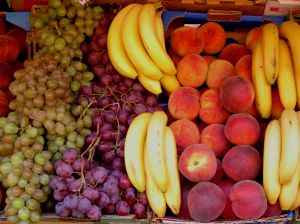THE TREATMENT OF THE most ordinary diseases and Diet
As comes to
many diseases caused by the standard of living, they are often caused
by the issues mentioned above: excessive use of refined sugar,
bleached white flour, and refined carbohydrates such as white polished
rice, cornstarch, or white macaroni, as well as bad fats. Their
excessive consumption, combined with a lack of certain nutrients,
cause most of our society’s illnesses.
Below, we
are going to study some common diseases and consider how they can be
healed by means of diet. The basic rule concerning all diseases is to
decrease the amount of unhealthy food and excessive eating as well as
increase the amount of healthy food. This is how we can expect relief
of symptoms caused by many diseases.
Coronary thrombosis and THE CLOTTED ARTERIES.
The
two most common causes of death in Finland, the United States, and
generally in the Western countries are cardiovascular diseases and
cancer. These two groups are clearly the most common causes of death
in many countries and heart diseases account for approximately a half
of all the deaths (diabetes in adults, which is an ever-increasing
illness, also belongs to the cardiovascular diseases according to the
current classification). If these diseases could be kept in check, the
quality of life of many people would improve considerably and their
lifetime would also be much longer.
As far as
cardiovascular diseases are concerned, there is one feature common to
them: bad condition of the veins and clots forming inside the
arteries. When bad food is consumed for many years, it will cause bad
cholesterol to accumulate in the veins, in other words a certain kind
of fat will cling to the walls of the arteries. At first, this fat is
toothpasty and soft, but gradually it can harden to a chalky state,
causing blood clots and paralysis.
This kind
of soft fat has already been observed in young people. For example, in
the autopsies of young American boys from the Vietnam War – who were
well under 30 years of age – fat accumulations and developing lime
precipitates on the walls of the veins were observed. Thus, if these
very fit young men had layers of fat in their veins, it is certain
that other, more ordinary people have even more:
"What is
wrong sonny? Don’t start to vomit!” an incessantly belching
pathologist said and pushed his finger through the blue-black, sticky
substance that had caused the heart attack. When he turned the heart
in his hand, the damaged area came clearly into sight, but the blocked
coronary artery that had caused the attack was covered with a thick
layer of fat.
"It looks
as if someone had struck it with a hammer,” he said when he cut off
layers of fat that covered the rock-hard arteries.
When I
finally got used to his rudeness, I asked, "How often is it that you
find as much fat as this?”
He
scratched his head with the blunt head of a surgeon’s knife. ” I have
never seen a heart attack without piles of lard.” He caught the
handful of fat and raised the heart to the level of our eyes. ”Before,
there was not so much fat. But now everybody has it. People are as fat
on the inside as on the outside.” (30)
How can we
stop the bad development going on in our veins and arteries? Are there
other solutions, such as conventional medication, and can it be
prevented in advance?
The answer
is clear. Most of the artery blockages are created because of the
wrong food, so the direction of the development can be changed with a
more reasonable diet. For example, the following nutrients have been
observed to be useful to veins and to health in general:
Eating
fish
significantly
contributes to the prevention of cardiovascular diseases. It has been
observed that certain groups, such as the Eskimos and Japanese
fishermen, who eat plenty of fish have not suffered much from
cardiovascular diseases. These diseases have not occurred, even though
their diet may have been one-sided and unbalanced in some other way.
The
benefits of eating fish have similarly appeared in numerous studies.
For example, according to a study made in the University of Kuopio,
the mortality rate of heart patients eating fish decreased by over 60%
during a follow-up cycle of five years when compared to those who did
not eat fish at all (Newspaper Etelä-Suomen Sanomat, 28 July 2003).
According to this study, a healthy minimum quantity is three fish
dishes a week.
Good
preventive measures against heart diseases have been observed to be
fatty fish (salmon, rainbow trout, Baltic herring, herring, whitefish,
mackerel, sardine, and tuna, even though other fish species also
contain some fish oil). Fish oil has been found to decrease the level
of injurious fat, increase the fluidity of blood, decrease arrhythmia,
blood clots and heart attacks as well as decrease blood pressure and
auricular fibrillation. In addition to this, fatty fish has been
noticed to decrease the content of fat in the blood after a meal.
The reason
for the good properties of fatty fish has been considered to be, in
particular, omega-3 fatty acids. They are in fatty fish in a
long-chain form, but it is also possible to get them from rapeseed and
other vegetable oils or nuts.
Plant oils
such as rapeseed, soy, olive, and flaxseed oil as well as other oils
are a good preventive method against heart diseases (coconut and palm
oil are an exception, because they consist of different kind of fats).
Several plant oils include similar fatty acids (omega-3) as fish fat,
and it has been found that they decrease the cholesterol level, the
danger of blood clots and deaths caused by heart diseases. In the
Mediterranean, olive oil has been used for a long time, and the
mortality rate caused by heart diseases has been very low. The food
there has also contained plenty of healthy fruit and vegetables.
The use of
plant oils is indeed justified, because they contain plenty of single
and polyunsaturated fats plus vitamin E. These have been found to be
useful to the health of the heart and the body in general. Ordinary
cold-pressed rapeseed oil is especially useful, because it more
actively decreases the accumulation of harmful LDL cholesterol to the
walls of the veins than olive oil. In addition, rapeseed oil contains
more important fatty acids (linoleum acid, alphalinoleum acid, and
vitamin E) than olive oil. Both oils are also good in the sense that
they are suitable for baking.
Fiber.
One of the most important factors promoting health is fiber, as found
only in the vegetable kingdom such as in grains, fruits, vegetables,
berries, nuts, and seeds. There are two kinds of fibers: insoluble and
soluble. Both of are found in the vegetable kingdom, but insoluble
fibers are generally more common.
Fiber
plays a significant role in reducing cholesterol levels and generally
in preventing heart disease. It has been found that soluble fiber,
which is found especially in bran, oatflakes, barley semolina, as well
as some in berries, fruits (there is a lot of it in apples) and
vegetables, is useful in lowering cholestrol in the blood (For
example, oatflakes contain about 11% fiber, of which soluble
beta-glucan is about 5%. What is good about oat is that people who are
suffering from celiac can also eat it.). The benefit of fiber lies
in the fact that it binds cholestrol to itself in the digestive tract,
so that some of it is removed with feces instead of being absorbed by
the body.
A good
picture of the importance of fiber is given by a Canadian study
(Etelä-Suomen Sanomat, 9.2.2004), in which the amount of fiber was
increased to approximately double what it usually is. The subjects
were advised to eat a diet that included soy, almonds, oats, barley,
okra and eggplant, among others. According to the study, the effect of
a diet rich in fiber was such that it reduced the harmful
LDL-cholestrol by as much as 30%. It is a large amount when the effect
of the drug was 33%, and a low-fat diet alone was only 8.5%.
Fruits,
berries and vegetables
have been found in several studies to be good preventers of
cardiovascular diseases and other diseases. They should usually be
eaten about 500 grams per day, but already a daily dose of 200 grams
has been found to lower the risk of heart attack. Their heavy use is
generally clearly linked to reduced mortality from heart disease. The
effect of fruits, berries and vegetables on heart and other diseases
is based on a number of different factors. One of them is the
proportion of insoluble and soluble fiber, the latter fiber of which
has been found to lower the level of cholestrol in the blood.
Likewise, they are rich in antioxidants (vitamin C and E,
beta-carotene...), as well as flavonoids, which have been found to
lower the risk of heart and other diseases. In addition, they are now
available all year round in stores and also frozen, which can have
different combinations (pea - corn - paprika, etc.)
Vitamin C
is one of the antioxidants found to protect the veins of diabetics and
improve immunity in general. Its connection to heart disease became
apparent in a research project, conducted at the public health
institute of the University of Kuopio in Finland. They measured the
vitamin C content of blood plasma in over 1,600 middle-aged men. It
was noticed that those whose vitamin C content was low had a high risk
of suffering a heart attack. The risk was 3.5-fold compared to men who
had enough vitamin C in their blood.
There are
several good sources of vitamin C. One glass of orange juice alone
contains the amount needed a day. Other good sources are, for
instance: oranges (50 mg / 100 g) and citrus fruit, potato (15 mg /
100 g; generally consumed a lot), rutabaga and turnip (40 mg / 100 g),
all cabbages (50–110 mg / 100 g), strawberry (80 mg / 100 g),
cloudberry (100 mg / 100 g), black currant (120 mg / 100 g), parsley
(200 mg / 100 g), and sweet pepper (200 mg / 100 g).
Beta
carotene
is one of the antioxidants found to prevent heart diseases, especially
if we get it directly from food. For example, in the research of
Doctor Hennekens it was found that men who had a weak heart but who
used beta carotene, suffered almost half the heart attacks, strokes or
deaths than those who got a placebo (Reader's Digest, November 1994,
p. 28). Beta carotene also prevents cancer. In many studies, it has
been found that those who eat food including beta carotene very rarely
have cancer of the lungs or intestines (Reader's Digest, November
1994, p. 28).
An
especially good source of beta carotene is carrot, which satisfies the
daily need
(carrot
satisfies also the need of vitamin A, because the beta carotene turns
into vitamin A in the body).
Other good sources are, for instance, sweet pepper, spinach, cabbages,
tomato, parsley, apricot and sweet potato.
Vitamin E
is one of the antioxidants found to effectively prevent heart disease
and decrease accumulating of cholesterol to the veins (Reader's
Digest, November 1994, p. 28). It has been observed to prevent certain
forms of cancer, such as prostate cancer (the most common cancer of
men in Finland.).
Good
sources of vitamin E are plant oils (for example, sunflower, corn,
rapeseed, soy, and wheat germ oils), whole meal grain, avocado,
vegetable margarine, and also eggs that are one of the most versatile
food on earth (there are vitamins A, D, E and K, minerals plus the
egg proteins include all the necessary amino acids).
Nuts
provide another good source of vitamin E. As little as a couple of
handfuls of peanuts, for example, can satisfy the daily need of
vitamin E. Nuts also contain many fats good for our heart (content
46–68%), protein (9–30%), fiber (in peanuts 8%), group B vitamins,
calcium, potassium, phosphor, iron, magnesium, zinc, copper, selenium,
and ubiquinone (for example in peanuts; it can also be found in
fatty fish and meat) that has been regarded as an important tool
against ageing.
Nuts are
important in preventing heart diseases. Numerous studies and
publications have indicated that people who eat plenty of nuts seem to
have a smaller risk of getting diabetes or die because of a coronary
disease. (Medical magazine Duodecim, 19 / 2004). It has been found
that ordinary nuts improve fat values of blood and decrease the risk
of a cardiac arrest and diabetes by about 30–50% (Newspaper Lahti ja
ympäristö, 14 January 2005, p. 3).
Flavonoids
are ingredients that have been noted to prevent heart diseases,
cancer, asthma, and other diseases. The most important sources of
flavonoids are apples, onion, garlic, sweet pepper, black currant, and
several forest berries. It is said that onion prevents clots and
decreases cholesterol levels. In the same way, according to the
studies of the National Cancer Institute of the United States, garlic
is shown to be the best food to prevent cancer (newspaper Etelä-Suomen
Sanomat, 13 January 2004). Flavonoids are abundant, for example, in
lingonberries, blueberries, cranberries. Cranberry and blueberry also
prevent urinary tract infections well. Similarly, ordinary fresh
juices and sour-milk products can protect against urinary tract
infections, as do ordinary juice and sour milk (newspaper Etelä-Suomen
Sanomat, 6 March 2003, p. 25).
Lycopene
and selenium
are believed to prevent heart diseases. Tomato and tomato products
contain plenty of lycopene, for example. Selenium can be found in
whole meal grain, meat (except not in areas where the selenium content
of the soil is low), fish, tomato, onion, shellfish, mollusks, nuts,
and also many mushrooms.



